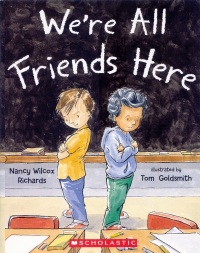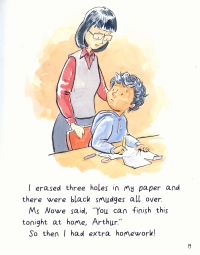| ________________
CM . . .
. Volume XXI Number 5. . . .October 3, 2014
excerpt:
Arthur and Sonny do not get along. Sonny thinks that Arthur is too messy and too noisy while Arthur thinks that Sonny is too quiet and neat. Their teacher likes to tell them that everyone in class is friends, but these two boys don’t believe it. At least not until Arthur has to miss the bus ride home because of a dentist appointment, and Sonny realizes that it’s not quite the same without him around.
The intention of this story is a good one, but unfortunately, the execution of the We’re All Friends Here fails to reach the concept’s full potential. There are a few issues with this story. One problem is that the tale is somewhat inconsistent. First, the reader is led to believe that Arthur and Sonny do not like each other. However, the text of the story later implies that Sonny dislikes Arthur, while Arthur is actually under the impression that he and Sonny are already friends. This can be seen by the fact that Arthur looks forward to telling Sonny all about his dentist visit, even though a few pages earlier he seemed to be complaining that Sonny was too perfect. There is also no real resolution in this book. Both boys describe a school day from their own point of view, and the reader gets to see that neither boy intends to be mean, but that they both perceive animosity and anger in their interactions. This is a great beginning for a story about how not everyone is the same, but, in the end, the boys don’t learn anything about appreciating one another’s differences. Arthur misses one bus ride, and while Sonny has always hated riding the bus with Arthur, this one absence apparently makes him miss his “friend”. As far as the reader can tell, the boys still think that they are being mistreated in class and that the other boy is mean and rude or stuck up. The final illustration of the book shows the two boys smiling and talking together, suggesting that they’ve decided to be friends. But the reader never gets to see the resolution of their differences, and there doesn’t seem to be any active incident that changes their opinions. The ending is abrupt and doesn’t make much sense given the background that the boys have supposedly disliked each other since nursery school. The result is that the whole tale feels incomplete. The layout of this story may also be confusing for some readers. The point of view switches between Sonny and Arthur, and, while at first, these different sections are clearly marked out with an illustration (in which Sonny draws a picture of Arthur surrounded by mess, and later Arthur draws a picture of Sonny with a halo above his head), further on the book switches between the characters without warning and with no stylistic differences to help readers distinguish between the two separate voices. Some readers may not have any difficulties with these switching viewpoints, but for others, this change could interrupt the flow of the narrative. We’re All Friends Here is a story with a strong premise, but it unfortunately fails to make the proper impact. The tale may be somewhat confusing for readers, and the ending is too quick to be satisfactory. A more active incident to show the boys that their differences do not have to stand in the way of their friendship would have given this story a stronger purpose. However, as it is written, We’re All Friends Here does not offer much beyond a somewhat muddled story about two boys who don’t seem to know whether they are friends or not. Not Recommended. Meredith Cleversey is a librarian in Cambridge, ON. She loves to read, write, and live in a world of pure imagination.
To comment
on this title or this review, send mail to cm@umanitoba.ca.
Copyright © the Manitoba Library Association. Reproduction for personal
use is permitted only if this copyright notice is maintained. Any
other reproduction is prohibited without permission.
CM Home | Next Review | (Table of Contents for This Issue - October 3, 2014.) | Back Issues | Search | CM Archive | Profiles Archive |

 Nancy Wilcox Richards has created a story that highlights an important aspect of meeting new people, which is that, sometimes, individuals are so unalike it makes it hard for them to get along. Sonny and Arthur are both good boys, but they have trouble understanding that, just because the other boy is different, it doesn’t mean that he is bad. Throughout the tale, the boys recount their own versions of classroom incidents, including a lunchtime mistake and an accidental tripping in gym. The detailed and often full-paged illustrations by Tom Goldsmith help to showcase each incident, sometimes even including information the narrator doesn’t notice, such as that the boys get their lunches mixed up because they share the same type of lunch box.
Nancy Wilcox Richards has created a story that highlights an important aspect of meeting new people, which is that, sometimes, individuals are so unalike it makes it hard for them to get along. Sonny and Arthur are both good boys, but they have trouble understanding that, just because the other boy is different, it doesn’t mean that he is bad. Throughout the tale, the boys recount their own versions of classroom incidents, including a lunchtime mistake and an accidental tripping in gym. The detailed and often full-paged illustrations by Tom Goldsmith help to showcase each incident, sometimes even including information the narrator doesn’t notice, such as that the boys get their lunches mixed up because they share the same type of lunch box.